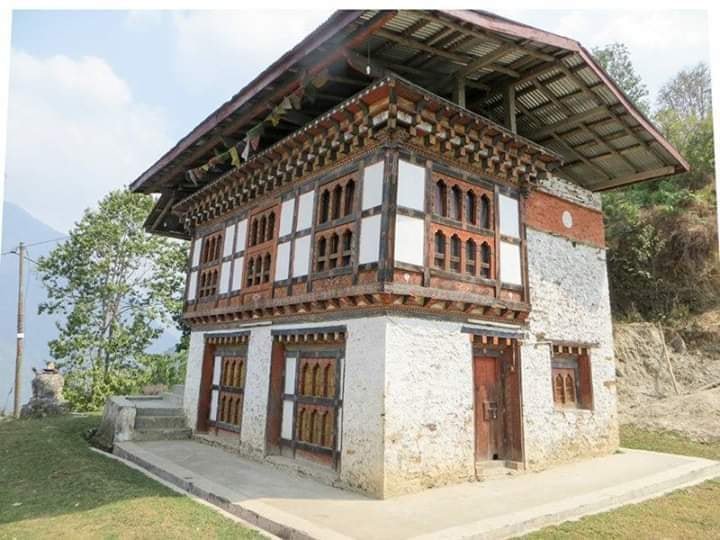Mongling Lhakhang
Build On:
19th – 20th century
Category:
Temple
Address
Zhemgang

The temple is located on a hill top above Nimshong village with a very peaceful surrounding. It is approximately 73 kilometers away from Zhemgang town towards the southeast connected by Dakphel-Buli Shingkhar farm road.
Mongling (means above in the Kheng language) lhakhang was a privately owned temple built between 19th – 20th century.A The temple is called as Mongling lhakhang because of its location above Nimshong village. The temple was handed over to the government about 20 years ago as the owner could not renovate the temple. However, the temple is still looked after by Aum Lemo, former owner’s family.
The date of the establishment of the temple dates back to the late 19th and early 20th century during the reign of the first king Ugyen Wangchuck. According to oral history, the temple was constructed by lam Damchoe Tandin, the brother of lam Yeshey who built Phumedthang temple just 3 kilometers away from Nimshong village. The reason for constructing the temple was to keep away tigers and other wild animals that inhabited the dense forest that surrounded the village. Though there were no temples built in the region, but there were many Ney (sacred sites) related to Guru Rinpoche. There were also many religious practitioners from the region who travelled to Tharpaling in Chume, Bumthang to study Buddhism.
Lam Damchoe initiated the construction of the temple and the local people from Nimshong village helped him in completing his mission. After the completion of the temple, gradually the villagers overcame their fear of tigers and wild animals, and Buddhism also flourished in the area. The temple houses a large statue of Jampelyang (Manjushri) as the main relic. The local people believe that it is the local deity Jampai Shenjey (the pronunciation for Jampelyang and Jampai Shenjey are close). Therefore, people worship the Jampelyang statue believing it to be Jampai Shenjey.
The village community believes that if someone touches, or takes things from the temple, or if someone goes against the owner of the temple, then that person would fall sick, or misfortunes may befall on domestic animals, or crops. Although, these things didn't happen, but the fear of harm is still there in the minds of the villagers. The villagers make offerings to the local deity Jampai Shenjey whenever there is a misfortune in the family, or for safe travelling, and also for success in their studies, or any other endeavour that people hope to achieve.
The temple is a one-storey square Bhutanese house with one room built in a typical Bhutanese architecture. The statue of Manjushri is placed in the main altar. The wall on the left hand side has paintings of Drakmar Phurshamchen (actually it is Guru Drakmar, but the lower half is phurpa (vajra), hence Drakmar Phurshamchen); and to the right hand side is the painting of Zhabdrung Tshering Chenga (Zhabdrung and the 5 sisters of Longevity). On the west wall, there is a faded wall painting of Kunzang Yabyum (Samantabhadra-Samantabhadri) with the 42 Peaceful deities (Zhiwai Lhatshog). The paintings of the 58 Wrathful deities (Throwai Lhatshog) cover the east wall, which were added to the peaceful deities to make the cycle of the Hundred Peaceful and Wrathful Deities.
There are 12 volumes of the Bum text (Prajnaparamita in 100,000 verses by Nagarjuna), which is considered sacred as it was written on daphne paper at the time of the construction of the temple. There are also 108 volumes of Kanjur (the Canon, translation of the words of the Buddha).
According to Meymey Tsipa (84 years old), the first renovation of the temple was carried out by Meymey Kuenzang (son of lam Damchoe Tandin). He extended and enlarged the original temple along with the existing wall paintings, but the exact date of renovation is unknown. It was renovated when Meymey Tsipa was a child. Therefore, it is likely that the temple was renovated approximately about 75 years ago.
Although the temple is looked after by the government, festivals and annual ritual activities that were in practice since the construction of the temple still continue. Besides the usual rituals, the temple organizes social and religious functions throughout the year.
1. Kanjur recitation is done from the 8th to 10th day of the 1st month of the Bhutanese calendar.
2. Bum (Prajnaparamita) recitation is done from the 8th to 10th day of the 4th Bhutanese month.
3. The annual Kanjur and Bum recitation is voluntarily hosted by a group of households based on convenience, faith, and the ability to sponsor the activity. The Kanjur and the Bum texts are recited by both monks from Phumedthang lhakhang and gomchens (lay monks) from Nimshong village.
Tagayla Tshechu is conducted on the 10th day of the 7th month of the Bhutanese calendar.
Tagayla Tshechu is the main festival of the year (which means kind of a rehearsal in local term because Tagayla Tshechu is the first to be performed in the area, and other local festivals and celebrations follow thereafter). During the festival, the villagers come and witness the Tshechu as it is the time when most agricultural work such as the harvest are completed. Therefore, from each household the head of the family (mother) offers their freshly harvested crops and butter lamps to the deities, to seek peace and prosperity for the community, and for the wellbeing of the family and their animals. It is believed that during that Tshechu people are filled with happiness because it is the beginning of a number of other festivals that follow, whereby they can gather and relax with their family and friends. There is no masked dance at the Tshechu as such, but gomchens (lay-practitioners) perform the ritual honoring Guru Rinpoche. The local people consider this very sacred as it is the beginning of all the festivals and celebrations in the village.
Source:
Bhutan history, FB
Researcher,Sangay Phuntsho
Researcher,Sangay Phuntsho
Reviews
No review available







